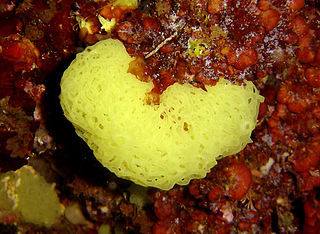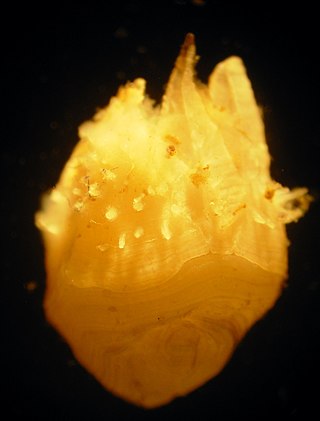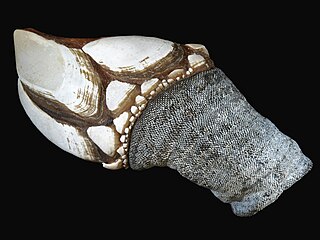
A salp or salpa is a barrel-shaped, planktic tunicate. It moves by contracting, thereby pumping water through its gelatinous body, one of the most efficient examples of jet propulsion in the animal kingdom. The salp strains the pumped water through its internal feeding filters, feeding on phytoplankton.

Clathrina is a genus of calcareous sponge in the family Clathrinidae. Several species formerly in Clathrina were transferred to the newly erected genera Arturia, Ernstia, Borojevia, and Brattegardia in 2013. The name is derived from the Latin word "clathratus" meaning "latticed".

The Balanidae comprise a family of barnacles of the order Balanomorpha. As a result of research published in 2021 by Chan et al., the members of the family Archaeobalanidae were merged with this family.

The Cox Science Center and Aquarium is located in West Palm Beach, Florida. Founded in 1959, the goal of the organization is to open every mind to science through the strategic programming of interactive exhibits and engaging community-based camps and events. The Cox Center has expanded since its creation and now houses over 50 hands-on exhibits, a planetarium, a 3000 square foot aquarium, a miniature golf course, and a large exhibit space that displays a temporary travelling exhibit. The Cox Center is a member of the Association of Science-Technology Centers program, which offers a membership that is redeemable at other ASTC science and technology centers around the world. The Cox Center occupies Dreher Park alongside the Palm Beach Zoo and offers deals for entrance to both facilities.
The World Register of Marine Species (WoRMS) is a taxonomic database that aims to provide an authoritative and comprehensive list of names of marine organisms.

Bittium is a genus of very small sea snails, marine gastropod molluscs in the family Cerithiidae, the horn snails.

Acasta is a genus of barnacles in the family Balanidae, containing the following species:

Raphitoma is a genus of sea snails, marine gastropod mollusks in the family Raphitomidae.

Alvania is a genus of minute sea snails, marine gastropod mollusks or micromollusks in the family Rissoidae.

Pollicipes is a genus of goose barnacles, first described by William Elford Leach in 1817. It comprises four species of marine suspension-feeders.
Conopea is a genus of barnacle, containing the following species:

Baía de Tarrafal or Tarrafal Bay is a bay of the Atlantic Ocean on the northwest coast of the island of Santiago in Cape Verde. The town of Tarrafal lies at its southeastern shore, and 643 m high Monte Graciosa rises from its northern shore. Most of its coast is rocky, but there is a stretch of beach near the city. The headland Ponta Preta marks the northwestern limit of the bay; there is a lighthouse on it.

Poecilasmatidae is a family of goose barnacles.
Oxynaspis is a genus of goose barnacles in the order Lepadiformes.

Pollicipes caboverdensis is a species of goose barnacle in the family Pollicipedidae. It is found in rocky intertidal zones on the coasts of the islands Santiago, Sal and São Vicente, Cape Verde. The species was first described by Joana N. Fernandes, Teresa Cruz and Robert Van Syoc in 2010 after a 24.5 mm specimen collected from Ponta Preta, northwestern Santiago.

Semibalanus cariosus, commonly known as the thatched barnacle, rock barnacle or horse barnacle, is a species of acorn barnacle occurring in the northern Pacific Ocean.

Cryptolepas rhachianecti is a species of whale barnacle that lives as a passenger on the skin of gray whales and certain other species of whale in the northern Pacific Ocean.

Tetraclitidae is a family of sessile barnacles in the order Balanomorpha. There are about 10 genera and more than 50 described species in Tetraclitidae.
Suberea is a genus of sponges belonging to the family Aplysinellidae.














